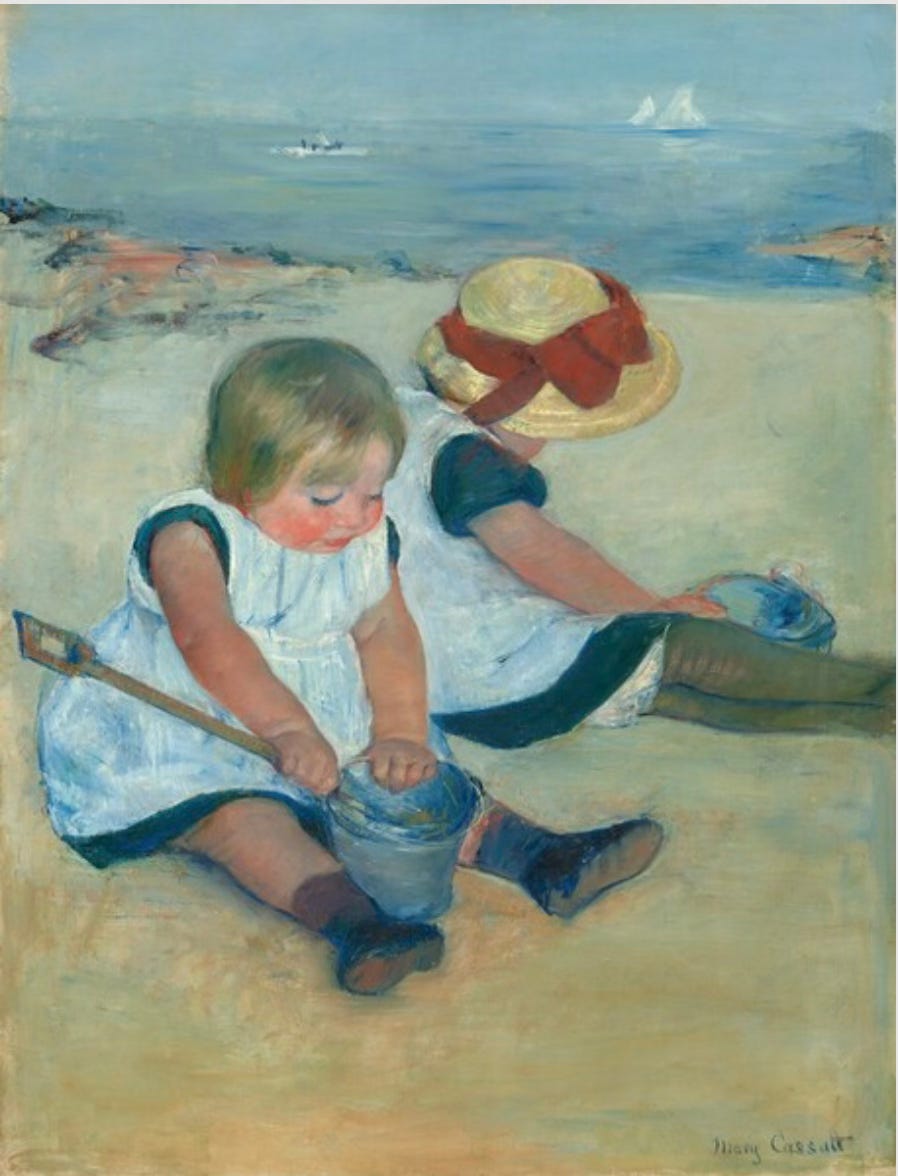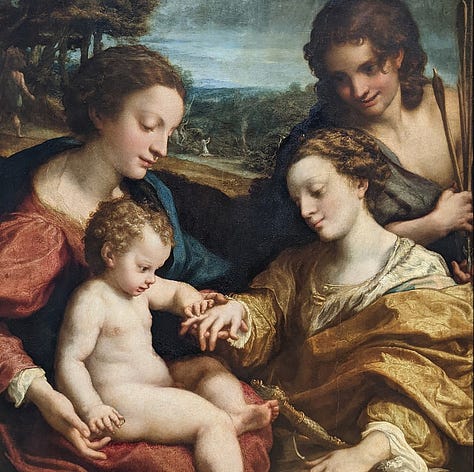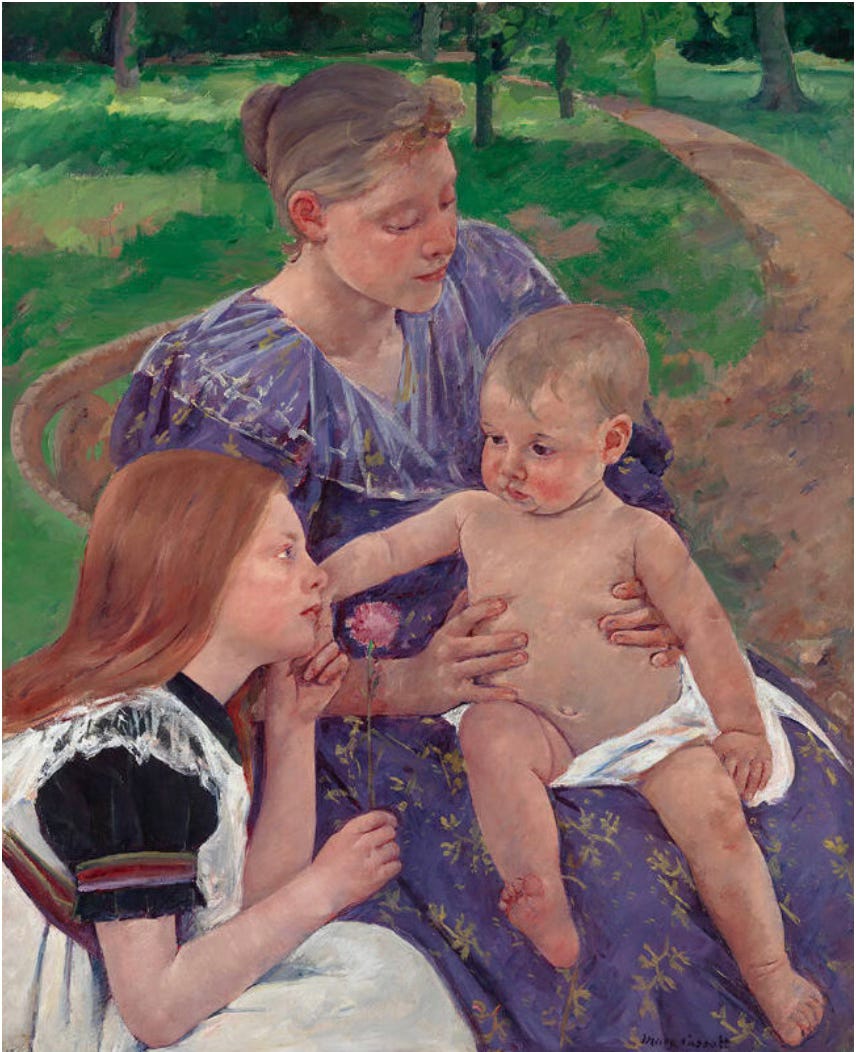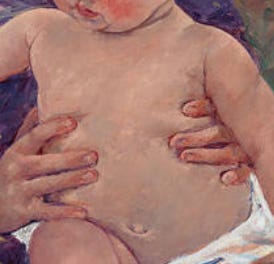Mary Cassatt's Mystic Marriage of St Catherine (wait, what?!)
Also, please don't give a baby a flower. They'll try to eat it. Notes about two paintings in the recent exhibition Mary Cassatt at Work.
Painting #1: Children Playing on the Beach and the pleasures of seeing a work in person after living with it in reproduction
I had the privilege of taking in the Mary Cassatt show, Mary Cassatt at Work, at the Legion of Honor in San Francisco with my mom. My mom loves Cassatt’s artwork; a poster of her Children Playing on the Beach hung in our house through my whole childhood. You might first think that her choice to display this painting was sentimental, given that it shows toddlers at play: she loves being a mom and is still terrific at engaging small children. And this may be part of its appeal to her. However, when I was a child, I remember her explaining that she bought the poster to remind her of the experience she had seeing it in person, and the reproduction was not nearly as good as the original—my first lesson in how incomparably wonderful it is to see art in person.

So it was particularly meaningful to me that I was able to see it in the exhibition—to see how the toddler’s cheeks were extra ruddy, her flesh extra dimpled, and her lips more shiny, and—especially—her focus on play with the sand bucket and shovel more acute. Reproductions tend to even colors and details out, but in real life the expression on the toddler changed to become more vivid.
Cassatt must have added the toddler’s double for compositional reasons. This “second” toddler is wearing a hat and stockings but is really the same one, shown pivoted next to toddler #1. It’s not a case of “continuous narration” as we’ve seen in recent posts (see this one published November 8, 2024 for definition and example), because there is no “story” behind this painting; Modern Art generally exists independent of a narrative. Instead, the second toddler balances the composition, provides a focus in the lush red of the ribbon on her hat, and extends the subject across and beyond the painting with her overly elongated legs and feet extending out of the picture’s edge.
TRY THIS: One activity you can do in a gallery, in front of an image that you want to explore, is to hold your thumb nail-facing in front of your eyes, to block out part of the composition with to see how it shifts the compositional balance—it might change the meaning of the artwork for you. Try it out and let me know what you think in the comments!
It doesn’t matter that toddler #2 sits less convincingly on the sand, or sports relatively unfinished, visible brushstrokes. This only heightens the focus of toddler #1, the focus on her play, which Cassatt underscored with more detailed painterly attention on her hands and face. Play, the curators of the exhibition argue, is the child’s work, just as Cassatt’s paintings and prints were her work, as an ambitious, experimental, and perceptive artist.
This exhibition made the overall argument about Cassatt as a working artist unsentimental about her subjects. She wasn’t making pictures of mothers and children in a treacly sweet Victorian parlor. Rather, her art contains her seriousness as an artist at the forefront of the Impressionist moment. Like the other Impressionist painters working in Paris in the late 19th century, she too found inspiration in Japanese wood block print, and invented new printmaking techniques to serve her purposes. She chose subjects from quotidian, modern life, and painted with an immediacy and brightness of palate and brushstroke.
If she painted mothers and children, it was because she found a unique and ever repeatable subject in the domestic sphere, to which she had greater access as an upper class woman. Her counterparts, who even with or especially because of their aristocratic backgrounds, like Henri Toulouse-Lautrec or Edgar Degas, could hire nude models, befriend prostitutes, hang out backstage at the ballet or horse racetrack, and study spaces that would have been nearly unthinkable for her to go (like the Moulin Rouge) given her social standing. (See my post dated September 20, 2024 on Toulouse-Lautrec’s painting At the Moulin Rouge for more background.)
Sometimes people say you have to be a woman or at least a mother to know the changing bodies of babies, their fleeting movements and stages, and perhaps this helped— Cassatt might have been more welcome to hold and observe small children because of her gender. But she never became a mother, and often hired servants to pose as mothers, and was still able to capture tricky moments with wiggly babies or depict the displacement of their chubbiness under your fingers. This is ultimately because of her acute observation, an essential and non-gendered attribute of great artistry everywhere.
Painting #2: The Family and a refining of Cassatt’s references to Madonna and Child paintings
Yet even when Cassatt’s work takes “Modern Life” as her subject, her work can’t help but be seen in conversation with older painting traditions. The comparison to the long western tradition of painting the Madonna and Child was inescapable, given that she was working in Europe and studying at the Louvre. One room of the show at the Legion of Honor addressed directly her relationship with this Old Master* theme of the Madonna and Child. In the case of her painting The Family, loaned for the exhibition from the Chrysler Museum of Art in Virginia, the curators argue that it takes after Holy Family paintings with Mary, Jesus, and St. John the Baptist (Jesus’s cousin, just a few months older than he). I would argue that this painting references more closely the subject of The Mystic (or Mystical) Marriage of St. Catherine.



These paintings depict St. Catherine’s vision wherein the baby Christ, sitting on his mother Mary’s lap, place a ring on her finger in marriage. If you want to look at several more images quickly to get a sense of this extremely common subject, feel free to pop over to Wikipedia’s entry on the Mystical Marriage of Saint Catherine to see a long and inconclusive list of Madonna and Child with St. Catherine paintings.

In Cassatt’s The Family, a woman in a purple dress holds a chubby naked baby on her lap, looking towards a girl in profile who gazes intently up at the baby’s face. She grasps the baby’s hand and presses it into her cheek, a lover’s gesture, and in her other hand she holds a pink carnation, sometimes just called a “pink,” a symbol of love and marriage since at least the early Renaissance (see below for an example). Usually when you find pinks in Madonna and Child paintings, it is a symbol of Christ’s divine marriage to Mary, his mother; here, I think the flower references St. Catherine’s visionary marriage to Christ.
Cassatt reinforces the loving relationships here with her painterly attention. Her focus is on the active hands and the gazes of the figures—the “mother” gazing down at the baby, “Catherine’s” gaze up at the baby’s face, and the baby’s less determinate gaze, either looking at “Catherine” or at the flower she holds. Cassatt captures this so well, since babies at this age do sometimes have trouble focusing their gaze. She also has observed the baby’s elongated head, neckless jowls, ruddy cheeks, and—especially—the displacement of the baby’s flesh under and between the “mother’s” firm, gentle grasping fingers.



Cassatt gives “Catherine’s” hands focus, too, especially when compared to the baby’s foot, that kicks out of the picture plane to help connect us, the viewers—but that’s a less important detail for Cassatt, who also gives short shrift to “Mary’s” chair or the verdant background and path, only there for compositional reasons. Next week I’ll define and write more about the picture plane more in a discussion of a work on St. Catherine by Veronese (teaser image below).



Cassatt connects “Catherine” to the mother and child by including her in the triangular/pyramidal composition, a common compositional shape classic to the Renaissance, and by giving both of them gauzy, embroidered organza, in a collar on “Mary’s” purple dress, and the ruffles of “Catherine’s” pinafore. This painting by Raphael conveniently (for me) has both carnations symbolizing marital love and a triangular/pyramidal composition.


Why might Cassatt have invoked the traditional Madonna and Child (with St. Catherine) genre? It might be to have it both ways: to be a Modern Artist with a brightly colored palate and visible brushstrokes, while taking the subject as series in the matter of Monet’s haystacks or Degas’ dancers; while also including herself alongside the great artists working within the long, serious project of Western Art, like Raphael. I might also argue that she invites us to put ourselves in “Catherine’s” position, not in a devotional way as though to worship or mystically marry Christ, but rather take on a more universal wonder. To this end, Cassatt hides the gender of the baby—it could be any or every baby. “Catherine”—by Cassatt—channels a fascination with babies, how difficult they are to capture, to understand, to satisfy. We can marvel about their already inherent individual characters, how impossible it is to know what they are thinking—we can only guess based on their immediate past and our experience in general. I think Cassatt understood this based on her own observations and interactions with small children, working—and succeeding—to capture this potential fascination in her many paintings of them.
*Art historians say “Old Master” painting/drawing/prints etc. for works created before the modern era, particularly from the Renaissance up to the French Revolution. It would be okay with me if this term becomes old-fashioned, but it is still in common use so I define it for you here.




I was always fascinated by Cassatt's focus on mothers and babies as subject matter in juxtaposition to her own life. A remarkable woman who came from riches, but provoked her father's enmity by choosing to pursue a career as an artist.
I've a habit of taking photos of every Madonna and child painting I come across -- now I need to go back through them and see if I can spot Catherine!